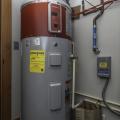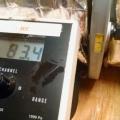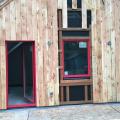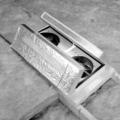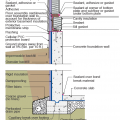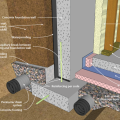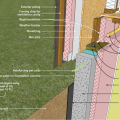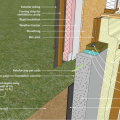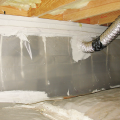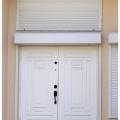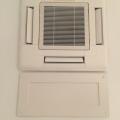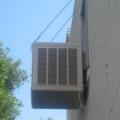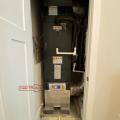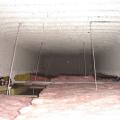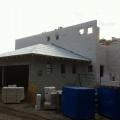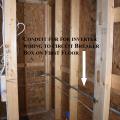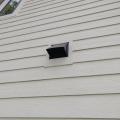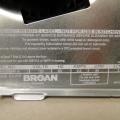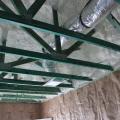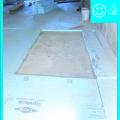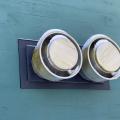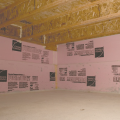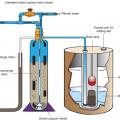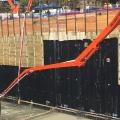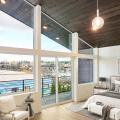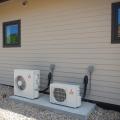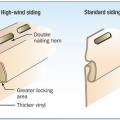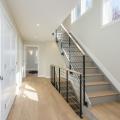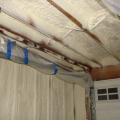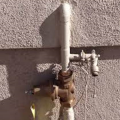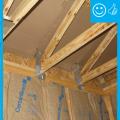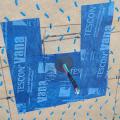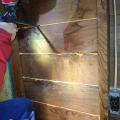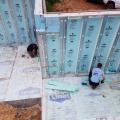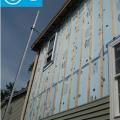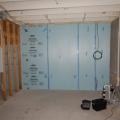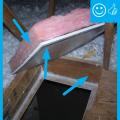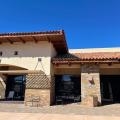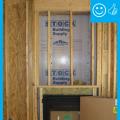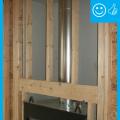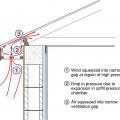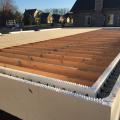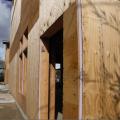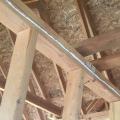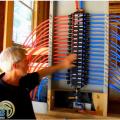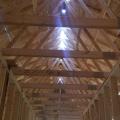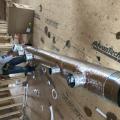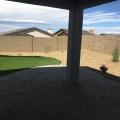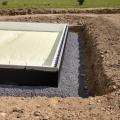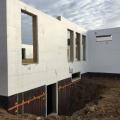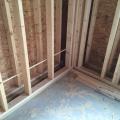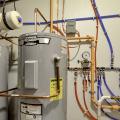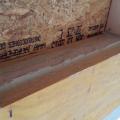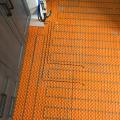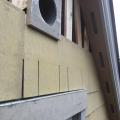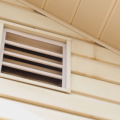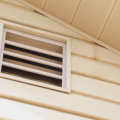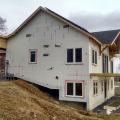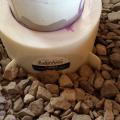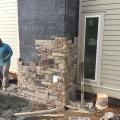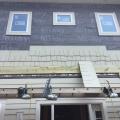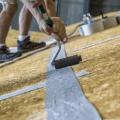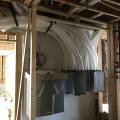Showing results 2501 - 2600 of 4973
Right - This 80-gallon heat pump water heater is ducted to pull heat from outside air drawn from the south side of the house and to exhaust cooled air outside on the north side of the house to efficiently heat water without impacting room temperatures.
Right - This air flow testing station includes a manometer to determine air flow rate for a whole house ventilation system.
Right - This builder preserved the trees around this new urban-infill home, providing excellent shading in the summer.
Right - This cedar siding is installed over furring strips which allow an air and drainage gap behind the siding.
Right - This ceiling-mounted mini whole-house fan has built-in insulated covers to reduce heat loss when the fan is not in use
Right - This concrete basement wall has exterior rigid insulation and comprehensive moisture management details.
Right - This concrete basement wall is insulated on the interior basement walls with spray foam and under the slab with rigid foam; footing details are shown.
Right - This concrete basement wall is insulated on the interior with rigid insulation; sill details are shown.
Right - This concrete basement wall is insulated on the interior with spray foam insulation; sill detail are shown.
Right - This concrete roof is properly attached and reinforced to withstand hurricane winds.
Right - This crawlspace, which is insulated on the floor, has a complete vapor barrier over the floor and up the walls that is sealed at all seams and termite inspection gap at the top of the vapor retarder.
Right - This duct penetration is properly flashed and integrated with the taped, foil-faced foam sheathing layer, which serves as the air and water barrier
Right - This ductless minisplit uses a ceiling-mounted rather than wall-mounted air handler.
Right - This enclosed parking garage in a multistory multifamily building is equipped with mechanical exhaust to remove airborne contaminants from the garage.
Right - This evaporative cooler is wall mounted to reduce leak effects and allow for ease of maintenance.
Right - This foil-faced polyisocyanurate rigid foam is installed on an existing exterior wall and the seams are taped so the rigid foam can serve as a water control layer
Right - This heat pump is located in a closet inside the home and all ducts are located within conditioned space between floors.
Right - This heated garage plenum is insulated along the bottom of the plenum space.
Right - This heated garage plenum is insulated and has an opening to access the interior, allowing for repairs and maintenance.
Right - This high-thermal-mass home uses masonry construction to naturally regulate temperatures inside the house
Right - This home was made PV ready with the installation of conduit and a dedicated electrical outlet for wiring from the roof to the circuit breaker box on the first floor.
Right - This home's windows have protective coverings that are raised to provide shade in good weather and can drop to protect the windows during high wind events.
Right - This house has key features to block heat such as such as tree shading for the west wall and roof, minimized west-facing windows, and a porch roof, floor, and wing walls creating deep architectural overhangs and fins to shade south-facing windows
Right - This kitchen exhaust duct termination is integrated aesthetically and functionally with the exterior cladding.
Right - This manufacturer's label shows a CFM higher than the requirement, increasing the likelihood that it will meet the performance level once installed.
Right - This new sealed attic has 5.5 inches (R-20) of spray foam insulation along the underside of the roof deck providing a conditioned attic space for the heating and cooling ducts.
Right - This opening in the foundation wall around this pipe was filled with wire mesh then sealed with spray foam to prevent rodent and insect entry
Right - This poured concrete basement wall is insulated on the exterior and under the slab with rigid insulation; footing details include interior and exterior footing drain pipe.
Right - This rigid insulation is correctly installed in a level layer over aggregate; the seams will be taped
Right - This roof has a low gable and is secured to the wall framing to resist wind uplift.
Right - This shared enclosed parking garage is equipped with exhaust fans to remove airborne contaminants from the garage.
Right - This shed roof is constructed with 1X4 furring strips installed over the decking and underlayment for ventilation beneath the metal roofing.
Right - This tiny house has a mono-sloped shed roof angled toward the sun to provide maximum space for solar panels.
Right - This tree has been given space around the roots to allow for proper growth and expansion of the tree over time.
Right - This unvented crawlspace is insulated along interior walls with rigid foam and air-sealed by covering the floor with vapor retarder that is sealed to the rigid foam which is taped at the seams.
Right - This unvented crawlspace is insulated along the walls and between the floor joists with 2-inch foil-faced polyisocyanurate; a termite inspection gap is visible above of the wall insulation and below the band joist.
Right - This water softener filters hard water through a mineral-collecting medium before delivering water to the main plumbing system.
Right - This waterproofing membrane on the interior of a deep soldier pile foundation with wood lagging is continuous, and penetrations through the membrane have been sealed.
Right - Triple-pane windows let in light and views while minimizing heat loss in winter and unwanted solar heat gain in summer.
Right - Two high-efficiency (12 HSPF, 26 SEER) ductless mini-split heat pumps heat and cool the home.
Right - Use flood-damage-resistant materials for decks and portions of the house below the design flood elevation.
Right - Walls and ceilings shared by the garage and living space must be air sealed and insulated.
Right - Water pressure reducing valves should be installed prior to fixture piping such as where water enters the home.
Right - Wind baffle installation will allow proper insulation depth over the top plate.
Right - Window shading is built into the south side of this home and east facing windows have been minimized to reduce heat gain from the summer sun while allowing low winter sun into the home
Right - Wood board sheathing seams are being sealed with low-expanding spray foam.
Right - Workers installed rigid foam on the floor and the sill plates of these pre-cast, pre-insulated concrete wall panels to provide a continuous layer of insulation under and around the not-yet-poured basement floor slab.
Right - XPS foam insulation is attached to the existing exterior wall with wood furring strips that serve as a nail base for the siding and are installed vertically to allow for drainage and drying behind the siding
Right - XPS rigid foam board is tightly installed against a concrete foundation wall and seams are sealed with tape prior to installing fibrous blanket insulation.
Right – Attic access hatch has been properly insulated by attaching a fiberglass batt, gasketed, and opening has blocking
Right – Deep overhangs, pergolas, and covered entryways minimize heat gain in this commercial building in the hot-dry climate.
Right – 11-inch ICFs provide R-50 of wall insulation from the footing to the roof on this cold-climate home.
Right – A 1-inch layer of XPS rigid foam covers the 2x6 wall studs and is topped by ½-inch-thick plywood sheathing, which is covered with draining house wrap and serves as a nailing surface for siding and trim.
Right – A bead of sealant will form an airtight gasket between the top plate and drywall.
Right – a booster fan was installed in this long dryer duct to increase air flow and help prevent the duct from being clogged with lint
Right – A builder of a DOE Zero Energy Ready certified home explains how a central manifold distribution system with PEX piping works.
Right – A chimney cricket is installed and flashed to direct rainwater around the chimney
Right – A contractor installs mastic in branch duct take offs to air seal the seams where they attach to the trunk duct.
Right – A deep porch provides shade and keeps sun off sliding glass doors in this Arizona home while artificial turf and xeriscaping minimize irrigation usage.
Right – A dehumidifier is installed next to the central heat pump’s air handler to pull air from the supply plenum, remove moisture, and re-introduce the air downstream in the supply plenum; this setup removes moisture efficiently.
Right – A dimpled plastic rainscreen product is installed over liquid-applied waterproofing on the exterior of the ICF foundation walls, directing water down the wall to the perimeter drain tile, thus encouraging drainage around the foundation.
Right – A dimpled-plastic rain mat was attached to the exterior below-ground walls to help minimize frost damage in cold climates.
Right – A double bead of sealant seals the seams between the SIP panel and spline.
Right – A flexible flashing product is installed around the corners of the window sill before installing the windows.
Right – A flexible tape is used to air-seal around wiring holes in the coated sheathing.
Right – A fully adhered roof membrane provides thorough water and wind protection in this mountain top location.
Right – A gap separates the two wall layers in this double-stud wall assembly allowing room for insulation to stop thermal bridging between the inner and outer wall
Right – A ground-source heat pump provides space heating and domestic hot water.
Right – A layer of sealant covers the wood-to-foam layer seams in the insulated header.
Right – A mall crew with a crane can assemble a home of structural insulated panels (SIPs) in just a few days.
Right – A mat is installed to contain radiant floor loops which distribute hot water from this home’s combi boiler.
Right – A metal flashing was installed behind the first row of siding above the windows to guide water over the trim.
Right – A non-combustible 1/8-inch mesh screen is installed on vent openings to reduce the risk of ember intrusion.
Right – A non-combustible 1/8-inch mesh screen is installed on vent openings to reduce the risk of fire from intrusion of wind-borne embers.
Right – A paint-on flashing was applied to the window frames of this ICF house before installing the windows.
Right – A protective membrane has been installed in the valleys and at the eaves of this roof before installing underlayment.
Right – A radon pipe provides a path for radon to vent to the roof rather than seeping into the home.
Right – A rain barrel is connected to the downspout of this home while a roll-up run-out on the downspout carries excess water several feet from the home during heavy rainfalls.
Right – A rigid corrugated rain screen product is installed shingle-fashion with overlapping edges behind rock veneer.
Right – A rigid rain screen product completely covers the wall behind the cladding and window framing.
Right – A simple stacked rectangular design and well-insulated and air-sealed ICF walls provide for an extremely energy-efficient structure.
